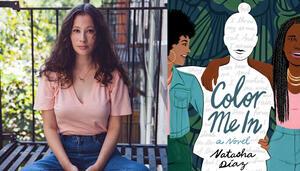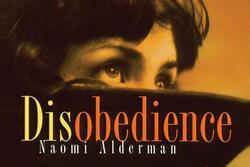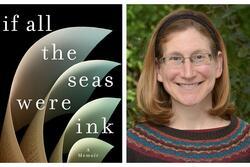An Interview with Natasha Díaz about "Color Me In"
JWA sat down with author Natasha Díaz to discuss her debut novel, Color Me In, one of our 2019-2020 Book Club picks. In Color Me In, Díaz pulls from her personal experience to weave a story about a girl growing up in New York City as a Black Jew. Throughout the story, Nevaeh Levitz discovers the meaning of friendship and strengthens her connections to all of her identities.
You and Neveah, the main character of Color Me In, have a lot in common, including your love of the written word. You both write beautifully about the complexities of simultaneously inhabiting different worlds and different identities. Have you always loved to write? What advice would you give to budding women writers, especially those trying to make sense of their identities through writing?
Thank you! I have always loved writing. My first word was actually “book,” which, I know, sounds like something I made up for PR, but I swear it’s the truth! Both of my parents are writers; my father is a poet and my mom is a playwright, so using writing as a way to express myself is a practice I have been immersed in my entire life. I am also an only child and I spent a lot of time with myself and my thoughts, so I used writing as a way to communicate when I wasn’t able or ready to vocalize what I was feeling or experiencing. In terms of advice, the best I can give is to keep writing, even if you take breaks. (Unless I am under a strict deadline, I have a very difficult time writing every day or meeting a specific word goal consistently.) As women, we are often taught from a young age to be quiet and polite, and that our place is somewhere tucked away neatly, or packaged in a palatable and easily accessible manner, but we have voices because we are meant to be heard. We have stories that need to be told. We have truths that need to be spoken. Believe me, there is a person out there going through something similar to what you are going through and would benefit greatly from your words, so keep going, fight through, and be loud.
When Neveah finds her mother’s journal, she becomes captivated by finding the truth about her. In a way, it seems like learning more about her mother helps her understand herself in a deeper way. Can you say more about the journal and why you included that storyline?
As I was writing Color Me In, the #MeToo movement was well underway and my mother joined the ranks of the many brave people who came forward about sexual abuse, assault, and harassment they had suffered at the hands of public figures. Watching her go through the scrutiny and backlash for telling her story made me take a step back and think about the way I, and I think so many people, hold their parents to such a high standard; we expect them to be infallible, which isn’t fair or possible considering we are all humans. As Nevaeh grows into herself, one of the lessons she learns is that she isn’t the only one struggling; everyone around her is dealing with something, whether it be a social issue, depression, bullying, abuse, etc., including her parents. I wanted her to grow in multiple ways and, since this was a realization I was having as I was writing, it found its way into the story.
As a white-passing biracial teen, Neveah struggles to own her privilege and use it to fight for justice. In the postscript to the book, you write that, similarly, you “quickly came to realize that [your] identity as a multiracial woman is inherently tied to [your] white privilege.” Can you say more about that?
As a multiracial woman who also presents as white, both of those aspects of my racial identity are inextricably linked. I cannot talk about one without talking about the other and I wanted to tell a story that recognized both truths. While there are some stories that touch upon the internal struggle that people of mixed race face with regard to feeling like we do not belong anywhere or have a right to claim and own our identities in their entirety, rarely have I found a narrative that also delves into the responsibility that is necessary for those of us who are light skinned or white presenting. Not everyone who is biracial or multiracial fits in that category. There are many people of mixed racial identity who are not white at all or who do not present in any way as white and deal with the same internal struggle in addition to the systemic oppression that People of Color face every day. The way that I relate to my communities and cultures of color is different as a result of my proximity to whiteness. The colorism that exists within communities of color that uplifts me for my appearance while bringing down members of the community who are darker skinned is something I feel I need to take steps to dismantle as opposed to remaining silent and allowing that bias to continue. It was important for me to incorporate all of these ideas into Nevaeh’s journey as she comes into herself as a multiracial woman, teaching her lessons and expanding the overall conversation about multiracial identity in its many facets.
Rabbi Sarah plays an integral role in Neveah’s Jewish journey and she also has an intriguing story herself. What inspired this character? What is her significance within the story overall, and towards Neveah’s exploration of her Jewish identity?
My relationship to my Jewishness is also complicated; being half Jewish comes with a lot of the same insecurities as being multiracial: the lack of “wholeness” lends itself to the belief that I may not be able to claim Jewishness or be Jewish, especially because traditionally, people say that religion is passed down from the mother and, in my case, my father is my Jewish parent. I spent a lot of time rejecting my Jewish identity because I felt as though it was another aspect of myself that made me different in my family. (I am much closer to my mom’s side where I was the one who looked white, had a different last name, and now, would not be baptized at my grandfather’s Baptist church where he was a pastor.) I am also not religious, but as I have gotten older, I have found connection to my Jewish ethnicity and culture, and a pride and ownership in it that I wish I knew could have existed outside of the religion, which I could have latched onto when I was coming of age. When I came up with Rabbi Sarah as a character, I wanted her to be someone Nevaeh could relate to in the sense that she has also at times felt like an outsider within her community as a result of her conversion to Judaism. Rabbi Sarah is integral to Nevaeh’s growth in that she shows her that there is not one right way to “be,” in terms of her racial identity, her inter religious identity, or her blended family. Many young people don’t have the opportunity to make their own decisions about faith, and I wanted Rabbi Sarah to act as a progressive member of the rabbinic profession who gives Nevaeh the tools and space to explore all aspects of herself and determine what speaks to her about Jewish community, culture, and religion.
In addition to Neveah, you present many other strong, complex female characters: Neveah’s mother, Corinne, Aunt Anita, cousins Jordan and Janae, and Rabbi Sarah. Were any of these characters inspired by women in your own life, and if so, how did that impact the way you wrote them?
While Color Me In is fiction, I did draw heavily from both people and experiences in my life as I was creating the characters. I wouldn’t say any of the women are based on people in my real life, but there are characteristics that I pulled from my family and friends, as well as phrases and patterns of speech that informed how I shaped them on the page. My mother and Corinne share a connection in terms of having endured a sexual assault (although Corinne’s experience is nothing like what my mother went through), Anita has some characteristics similar to those of an aunt I am extremely close to, as well as a cousin who is more like an aunt. Jordan and Janae are a big mash up of a lot of people, including myself (especially when it comes to Jordan’s tough love and unrelenting honesty). Rabbi Sarah is probably the character who is most formed from my imagination, though I did learn from a female rabbi during my Bat Mitzvah preparations. It was important to me that Nevaeh also study with a female Rabbi because I rarely see any religious leaders depicted as women in literature and entertainment, so I wanted to add to that representation. As she came to life, Rabbi Sarah became more of a life guide for Nevaeh than just a religious guide; she became a figure I wish I had had in real life.








This is an important story that I’ve never come
across in fiction. Thanks for giving us a fresh
perspective on interracial Jewish identity.
sounds like a fascinating read of one writer’s personal journey and coming to terms with the complexities of her identity. Thank you! Sheila